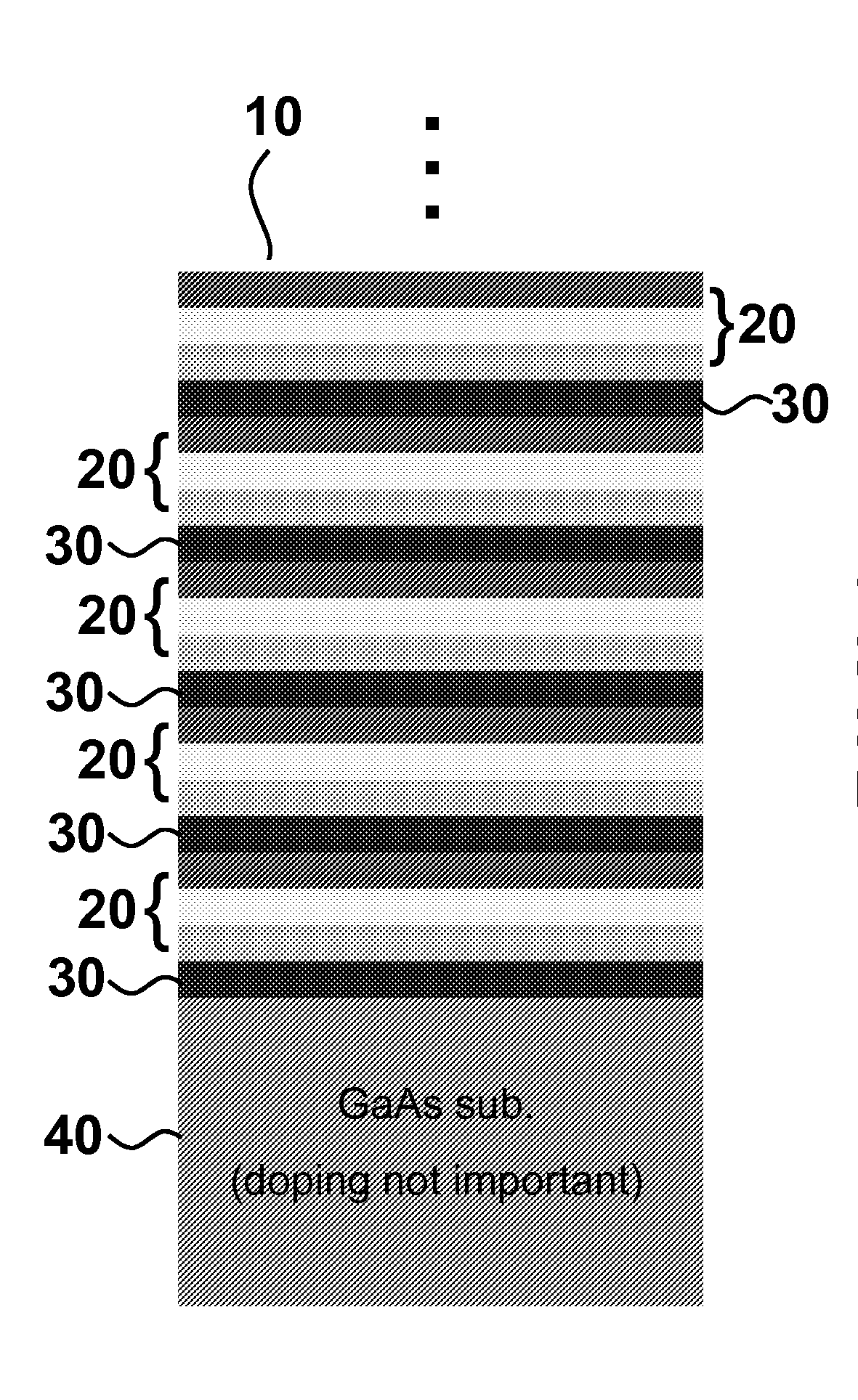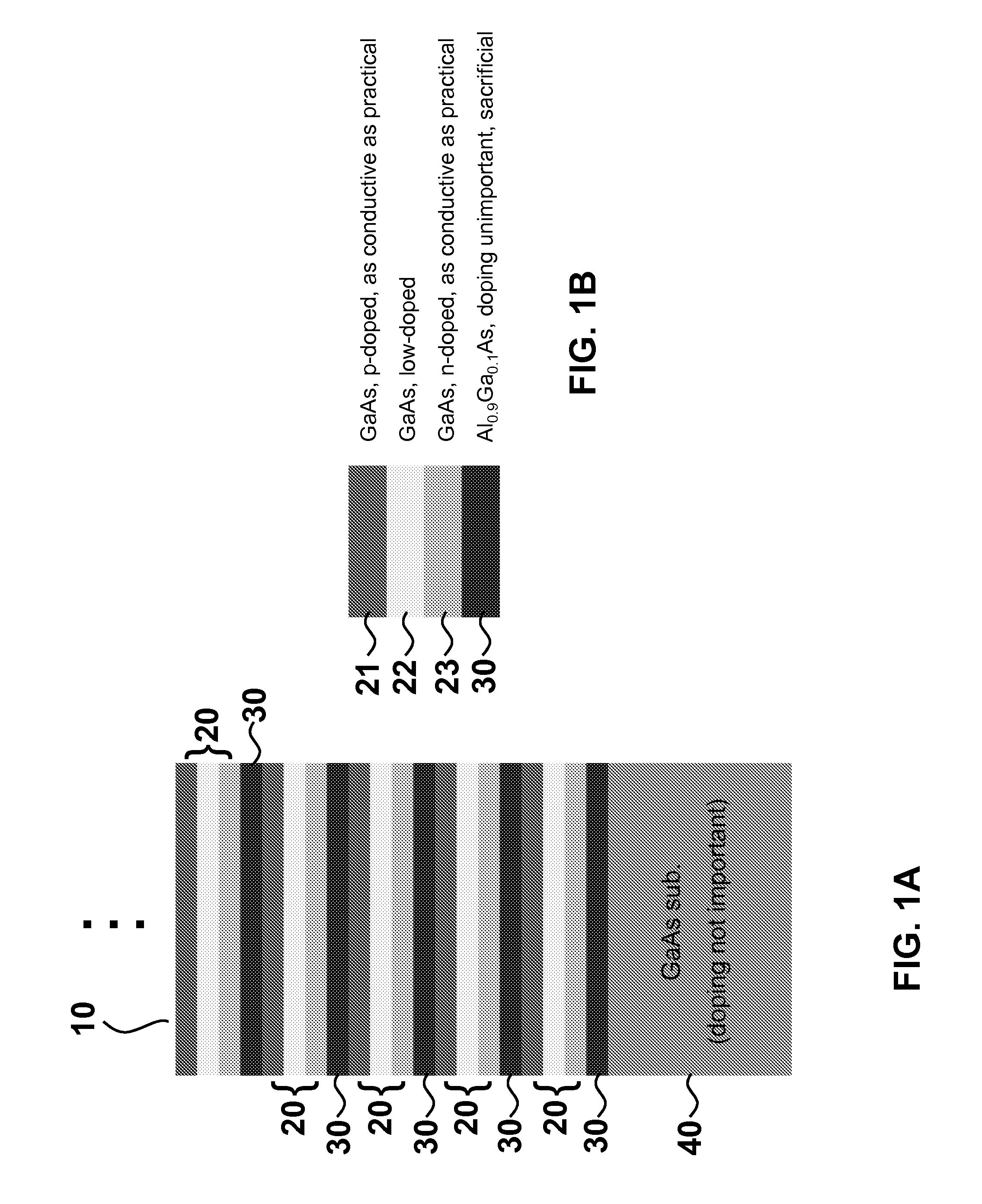Release Strategies for Making Transferable Semiconductor Structures, Devices and Device Components
a technology of transferable semiconductors and release strategies, which is applied in the direction of sustainable manufacturing/processing, final product manufacturing, nanoinformatics, etc., can solve the problems of significant decrease in manufacturing costs per solar cell layer and decrease the final cost of the end device or the device component, so as to facilitate low-cost generation of structures, reduce the final cost of the end device or the end device. the effect of the final cos
- Summary
- Abstract
- Description
- Claims
- Application Information
AI Technical Summary
Benefits of technology
Problems solved by technology
Method used
Image
Examples
example 1
[0098]Release of Transferable Structures for Photovoltaics, Electronics and LEDs.
[0099]FIGS. 3A and 3B schematically illustrate methods and structures for simultaneous removal of multiple release layers (FIG. 3A) and sequential layer-by-layer removal of release layers (FIG. 3B). In FIG. 3A, a portion of the multilayer structure 10 is exposed to etchant means, thereby forming an etched access passage 35. Passage 35 provides simultaneous access to a plurality of release layers 30 (three, in this example). In this manner, a plurality of transferable structures 100 are available for printing to a surface of interest, such as a device substrate or device component supported by a substrate by any means known in the art (e.g., liquid printing, contact printing, etc.).
[0100]FIG. 3B summarizes layer-by-layer removal, where etchant access channel 35 spans only the top-most functional layer 20 so that only a single functional layer 20 is released to provide transferable structures 100 from one...
example 2
[0109]Release of Transferable Structures by Laser Ablation.
[0110]Other release methods include release by removal of the mother substrate by grinding / polishing / etching or release by thermal shock (e.g. by thermal expansion coefficient mismatch). Release may also be by ablation / decomposition / chemical reaction of embedded layers, such as ablation / decomposition / chemical reaction caused by laser-induced heating. FIG. 6A provides a schematic illustration of a laser ablation release method. Electromagnetic radiation is introduced through an at least partially transparent substrate 40 upon which functional layer 20 is supported, such as by a laser positioned on the side of substrate 40 that is opposite the surface upon which the multilayer structure rests. Laser-induced heating causes release of transferable FMED 100 either by failure of interfacial surface between 20 and 40 or by at least partial removal of a laser-ablating sensitive release surface 30. Release surface 30 may remain parti...
example 3
[0111]Release of Transferable Structures by Propagation of an Induced Interfacial Crack.
[0112]Another release mechanism is by introducing a crack at an interface between FMEDs and the mother substrate and then pulling the FMEDs away from the mother substrate (e.g. using a rubber stamp) to propagate the crack (see FIG. 7A). The crack can be introduced in any number of manners, such as mechanically (e.g. by cutting; see FIGS. 8B-8C and 12), chemically (e.g. by etching) (see FIGS. 7B and 11), or thermally (e.g. by shock induced by thermal expansion coefficient mismatch).
[0113]Optionally, any of the above means for releasing a transferable structure is combined with a carrier structure, for example a carrier film (FIG. 8A), such as a gold film as a carrier structure for printing carbon nanotubes (see Nature Nanotech. Vol 2, p.230). This process can be effective for FEMDs that are small (e.g., less than about 50 nm, e.g. molecules, SWNT, etc.) chemically fragile, mechanically fragile, me...
PUM
 Login to View More
Login to View More Abstract
Description
Claims
Application Information
 Login to View More
Login to View More - R&D
- Intellectual Property
- Life Sciences
- Materials
- Tech Scout
- Unparalleled Data Quality
- Higher Quality Content
- 60% Fewer Hallucinations
Browse by: Latest US Patents, China's latest patents, Technical Efficacy Thesaurus, Application Domain, Technology Topic, Popular Technical Reports.
© 2025 PatSnap. All rights reserved.Legal|Privacy policy|Modern Slavery Act Transparency Statement|Sitemap|About US| Contact US: help@patsnap.com



